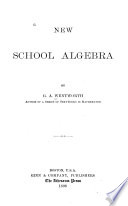 | George Egbert Fisher, Isaac Joachim Schwatt - Algebra - 1898 - 712 pages
...general, the method consists of a repetition of the following steps : The trial divisor at any stage is three times the square of the part of the root already found ; as 27 in the preceding example. After one or more figures of the root have been found obtain the... | |
 | George Albert Wentworth - Algebra - 1898 - 434 pages
...than the number of figures already obtained may be found by division without error, the divisor being three times the square of the part of the root already found. 88. Find the cube root of : 1. 4913. 3. 1,404,928. 5. 385,828.352. 2. 42,875. 4. 127,263,027. 6. 1838.265625.... | |
 | George Egbert Fisher, Isaac Joachim Schwatt - Algebra - 1900 - 484 pages
...found. The method consists of repetitions of the following steps : The trial divisor at any stage is three times the square of the part of the root already found; as 27 in the preceding example. 59' 319 39 27 32 319 2700 810 81 32 319 3591 30-33] HIGHER ROOTS. 233... | |
 | George Egbert Fisher, Isaac Joachim Schwatt - Algebra - 1900 - 206 pages
...[Сн. XII The method consists of repetitions of the following steps : The trial divisor at any stage is three times the square of the part of the root already found ; as 27 in the preceding example. Afler one or more figures of the root have been found, obtain the... | |
 | William James Milne - Algebra - 1901 - 476 pages
...to the consecutive powers of some letter. Extract the cube root of the first term, write the result as the first term of the root, and subtract its cube from the given polynomial. Divide the first term of the remainder by 3 times the square of the root already found, as a trial... | |
 | George Egbert Fisher, Isaac Joachim Schwatt - Algebra - 1901 - 646 pages
...found. The method consists of a repetition of the following steps : The trial divisor at any stage is three times the square of the part of the root already found ; as 27 in the preceding example. After one or more figures of the root have been found obtain Ote... | |
 | William James Milne - Algebra - 1902 - 620 pages
...to the consecutive pvicers of some letter. Extract the cube root of the first term, write the result as the first term of the root, and subtract its cube from the given polynomial. Divide the first term of the remainder by 3 times the square of the rout already found, as a trial... | |
 | William Kent - Engineering - 1902 - 1204 pages
...work is made by obtaining the last two figures of the root by division, the divisor employed being three times the square of the part of the root already found; thus, after finding the first three figures: 8x 123J = 45387|20498963|45.1 + —181548 234416 826985... | |
 | Webster Wells - Algebra - 1904 - 642 pages
...according to the poivers of some letter. Extract the cube root of the first term, write the result as the first term of the root, and subtract its cube from the given expression; arranging the remainder in the same order of powers as the given expression. Divide the... | |
 | George Washington Hull - Algebra - 1904 - 172 pages
...terms according to the powers of some letter. Extract the cube root of the first term, write the result as the first term of the root, and subtract its cube from the polynomial. Divide the first term of the remainder by three times the square of the root already found,... | |
| |